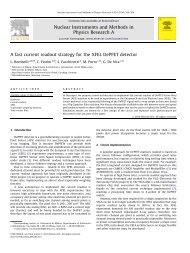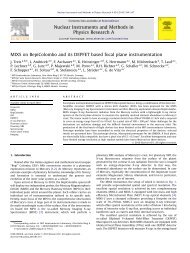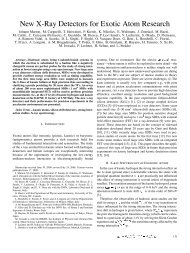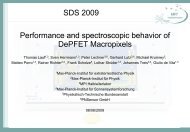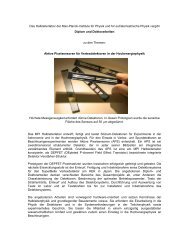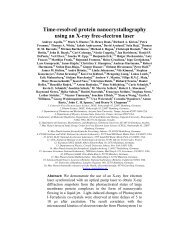DEPFET Pixel Vertex Detector for the ILC - MPG HLL
DEPFET Pixel Vertex Detector for the ILC - MPG HLL
DEPFET Pixel Vertex Detector for the ILC - MPG HLL
You also want an ePaper? Increase the reach of your titles
YUMPU automatically turns print PDFs into web optimized ePapers that Google loves.
second duo to preliminary limitations in <strong>the</strong> USB1.0-based readout hardware.<br />
Two different <strong>DEPFET</strong> sensor designs with 64 × 128 pixels of 36 × 28.5µm 2<br />
have been tested, one with high-E implantation, one without. The <strong>DEPFET</strong><br />
module was operated without zero-suppression to gain full insight into <strong>the</strong><br />
device behavior. Figure 28 shows an online display of <strong>the</strong> data taken with<br />
<strong>the</strong> beam spot in <strong>the</strong> 32 × 32 mm 2 large sensor of <strong>the</strong> beam telescope and in<br />
<strong>the</strong> 2.3 × 3.6 mm 2 large <strong>DEPFET</strong> matrix as well as <strong>the</strong> correlation between<br />
<strong>the</strong> two.<br />
Figure 28: Online displays showing <strong>the</strong> beam spot in a strip plane of <strong>the</strong> telescope,<br />
in <strong>the</strong> <strong>DEPFET</strong> matrix and <strong>the</strong> correlation between <strong>the</strong> two devices<br />
The main conclusion drawn from <strong>the</strong> beam test so far is that an <strong>ILC</strong>-like<br />
prototype system has been successfully operated in a particle beam. While<br />
<strong>the</strong> individual components (sensors, sequencer chip, readout chip) have been<br />
shown to operate close to <strong>ILC</strong> specs in <strong>the</strong> lab, <strong>for</strong> <strong>the</strong> test beam measurements<br />
still much slower operation parameters have been chosen. Fur<strong>the</strong>r<br />
analysis of <strong>the</strong> beam test data is under way. Follow up test beam periods are<br />
planned at DESY and Bonn (ELSA) and in 2006 at CERN.<br />
3.6 Estimation of Total Power Consumption<br />
One of <strong>the</strong> main advantages of <strong>the</strong> <strong>DEPFET</strong> concept is <strong>the</strong> potential of low<br />
power operation. In particular, <strong>the</strong> power dissipated in <strong>the</strong> active sensor<br />
area, where cooling is particularly difficult, is small. The readout chips,<br />
situated at <strong>the</strong> border of <strong>the</strong> modules, can be cooled more easily. The steering<br />
chips are mounted on a 300µm thick support frame in <strong>the</strong> active region<br />
of <strong>the</strong> vertex detector, so that <strong>the</strong>ir dissipation must be minimized. The<br />
power consumption of <strong>the</strong> sensor can be estimated assuming V Drain =5 V and<br />
I drain = 100µA (<strong>the</strong>se are conservative values) corresponding to 500µW per<br />
active <strong>DEPFET</strong>. The total number of pixels active at <strong>the</strong> same time in <strong>the</strong><br />
innermost layer 1 is 8192, located in 16 rows (2 on each of <strong>the</strong> 8 ladders)<br />
with 512 pixels each. The power dissipation during readout is thus 4.1 W.<br />
29


